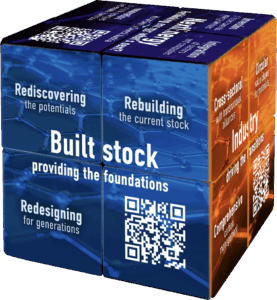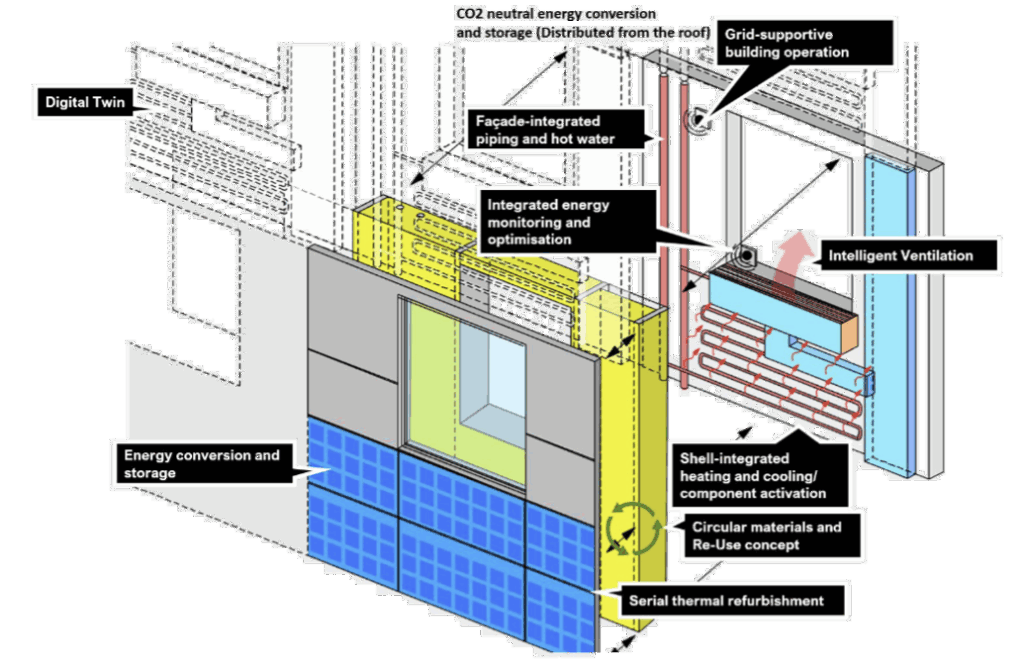Radical innovations in the existing building stock are emerging as the cornerstone of future-proof residential and commercial structures. These innovations foster more localized, self-sufficient energy systems and flexible mixed use. These visionary ideas are also reshaping mobility and accelerating the expansion of renewable energy.
New technologies are dramatically improving the energy performance of existing buildings. For instance, the “RENVELOPE—Energy Adaptive Shell” project (https://renvelope.at/) employs prefabricated façade elements that can be installed with minimal disruption and reduce energy consumption by over 80 percent.
Rediscovering the potentials of the built stock
Architects, developers, and policymakers are rediscovering the enormous innovation potential that is sleeping in the built stock.
Aiming for a deepened understanding of the built stock
An emerging understanding of the key role of the built environment in transforming our economies and improving individual and collective well-being requires, inter alia, a deepened knowledge of buildings and a deliberate narrative of targeted innovations for the built environment.
Notable examples of these innovative building concepts can be found in the so-called quarters / areals in Switzerland with the urban developments Suurstoffi (https://www.suurstoffi.ch/) and Papieri-Cham (https://www.papieri-cham.ch/).
Clustering the energy system in energy hubs
Buildings can support the infrastructure for the localized, highly integrated energy system, with the key components:
- Anergy grids
enable recycling of waste heat recycling and collecting terrestrial (geothermal) energy, thus covering fully heating and cooling services. - Local electricity
from in buildings integrated PV and other renewables enable self-sufficiency up to three-quarters of the electricity demand - Thermal building components
serve as a thermal storage for intermittent energy sources.
With these rediscovered potentials, cities can cut operational energy by 60-80 percent and embodied carbon by 40 percent or more. In addition, the existing building stock becomes more resilient, and fit for a net-zero future.
Rebuilding the current stock
The EU has about 220 million buildings. Roughly 80 percent of the buildings that will still be standing in 2050 already exist today. Many factors, including climate and energy, motivate renovations of the built stock.
Deep and performance-based renovation
This should become the norm to bring a building as close as possible to the Zero-Emission Building (ZEB) standard. These are supporting actions:
- Minimum energy performance standards (MEPS)
ensure that the worst-performing buidings are tackeled first. - Phase-out fossil heating
and deployment of heat pumps and renewable district heating
Whole-life carbon and circularity
Renovations should disclose
- Whole-life carbon (WLC) impacts
both embedded in construction materials and energy - Reuse of materials
by design for disassembly
Integrated financing and one-stop shops
To make renovations affordable
- Targeted financial tools
combine special grants, loans, guarantees, and tax packages - One-stop-shops
guide owners through the application process and the renovation works.
These actions will ensure that by mid-century, Europe’s buildings are not only zero-emission but also affordable and resilient places to live and work.
Redesigning for generations
For planning or life-cycle analysis, 80 years is now the most widely used average lifespan for ordinary European buildings. That reality makes it imperative to future-proof the built environment so it can endure for decades while remaining adaptable, sustainable, resilient, and supportive of social cohesion.
Multifunctional, dynamic, and flexible designs
These are some supporting strategies:
- Spatial integration
of living, working, and other activities to curb the need for daily travel. - Adjusting to the needs of tenants
so units can adapt as households grow, shrink, or age in place. - Flexibility to changes
allowing spaces to be reconfigured quickly as uses change.
Buildings as active players in the energy system
Buildings are being discovered as part of the infrastructure of the energy system:
- Building-integrated photovoltaics (BIPV)
turn façades and roofs into power plants, unlocking extensive, previously unused surface area for renewable generation. - Building-integrated thermal storage
employs thermal building components (TBC) to store heat and cold, smoothing demand and boosting grid flexibility
Buildings impact lifestyles and economic structure
As integral parts of the energy system’s infrastructure, buildings offer many opportunities:
- Adaptive reuse
by turning underutilized malls, offices, or parking garages into housing, which avoids demolition waste and satisfies growing housing demand. - Urban design
largely determines how far and how often people need to travel. - Renewable expansion
by using rooftops and façades make buildings prime real estate for expanding solar and other renewables. - Energy sharing
by linking groups of buildings to share energy boosts resilience and keeps costs down.


